Sami AwamiBBC Africa, Antananarivo
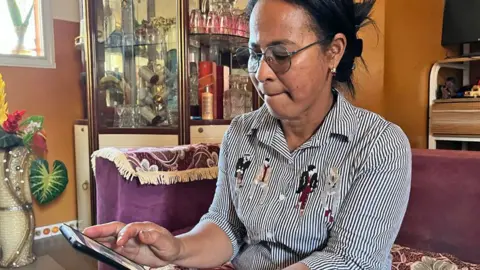 Sami Awami/BBC
Sami Awami/BBCRazanasoa Edmondine still looks shocked as she recalls the death of her one-month-old grandson, who was killed by police with tear gas during protests that have rocked Madagascar over the past two weeks.
“It was just an ordinary Friday,” she told the BBC at the family home on the northern outskirts of the capital, Antananarivo. “My daughter-in-law was going to the market with the child when she encountered protesters on the road.”
Shortly after, the police showed up and began breaking up the protest with tear gas.
It was the second day of the youth-led protests, sparked by anger over persistent electricity and water shortages, and Ms Edmondine’s daughter-in-law ran to a nearby building with other protesters to take cover.
Police then fired more tear gas canisters into the building, quickly filling it with choking smoke.
With chaos in the streets, they were unable to reach the hospital until the next day. By then, the damage had been done.
“The baby was trying to cry but no sound came out,” Mrs. Edmondine says quietly.
“It was as if there was something blocking his chest. The doctor told us that he inhaled a lot of smoke. Two days later, he died.”
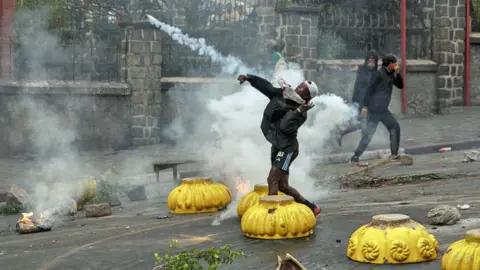 AFP/Getty Images
AFP/Getty ImagesHer grandson is one of at least 22 people the United Nations says were killed during clashes between police and demonstrators in the early days of the protests, which have since escalated into broader discontent over corruption, high unemployment and a cost-of-living crisis in one of the world’s poorest countries.
President Andry Rajoelina’s government rejected the figure as misleading information but did not provide its own figures.
However, it confirmed that the value of property damage exceeds $47 million (£35 million). The first days of the protests saw widespread violence, with cars set on fire, store windows smashed, and a two-month-old cable car station worth millions of dollars vandalized.
Raby, who only gave his first name to the BBC, accused police of firing live bullets at peaceful demonstrators, a few blocks away from where Edmondine’s daughter-in-law was hiding.
As police fired tear gas, panic quickly spread and people fled in every direction, seeking shelter inside any open building. But he says his 20-year-old autistic son didn’t understand what was happening.
“He must have sneaked out to see what was happening. Then the police shot him and continued to chase other protesters.”
He believes his son was shot from the front, because the bullet left a large open wound in his back – a likely exit wound.
“I don’t know much, but as far as I know, when someone raises their hands, it means they didn’t steal anything, they didn’t vandalize anything,” Raby says. “He was just there to see what was happening.”
In response to accusations of police brutality, President Rajoelina said earlier this week: “There have been deaths, and we completely agree with that. I truly sympathize with the suffering and pain of the families who have lost their loved ones.”
“But I want to tell you that these dead are not demonstrators, and they are not students. They are rioters. They are the ones who looted.”
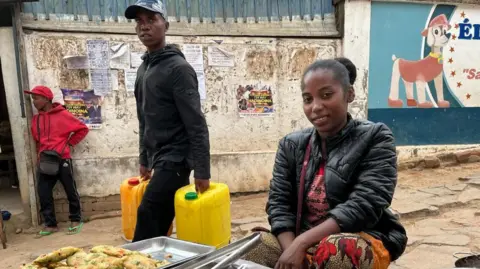 Sami Awami/BBC
Sami Awami/BBCSome business owners say the prolonged protests have disrupted business activity and reduced their income, especially for those living in downtown neighborhoods around the University of Antananarivo, where the protests were held.
“I fully support Generation Z, but I don’t think protests are the right way to address their grievances,” says Laza Brenda, who runs a roadside mobile phone repair kiosk. “When people demonstrate, I can’t do business.”
For entrepreneur Ulricia Rapitiavanna, the uncertainty has worried many of her international clients, who have canceled training contracts and seminars.
“We had to postpone a big event of over 2,000 people that we had been preparing for over six months. It was supposed to be held this week. Postponing everything and losing that money was a huge challenge for us,” says Ms Rabitiyavana.
The tourism sector on the Indian Ocean island, which is famous for its unique wildlife, is among the worst affected as the situation caught most people by surprise.
“We have only received cancellations. Mid-September and October are usually the busiest period for us,” says Francois van Rijn of Radisson Hotel Group.
“We’re usually at about 60 or 70% occupancy but now we’re down to 10%. So it’s like we’re at full throttle and all of a sudden the handbrake.”
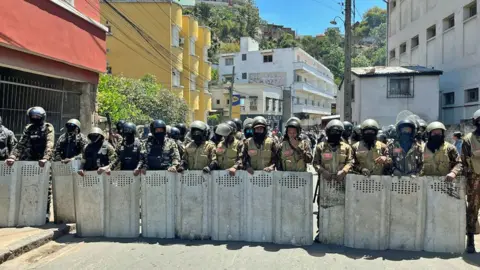 Sami Awami/BBC
Sami Awami/BBCThe youth movement behind the demonstrations, known as Gen Z Mada, has grown increasingly angry, with demonstrators now demanding the president step down.
Evidence of the frustration felt by young people, whether unemployment, water scarcity or struggling businesses, is not hard to find throughout Antananarivo.
At the airport, for example, visitors with just a few bags are soon surrounded by two or three young men eager to help in exchange for a small tip.
Anyone who leaves their car parked outside a café or restaurant will almost certainly be approached by two young men and demand a fee after claiming to be “guarding” the car.
On the side of the road, a young woman selling sweet cakes tells the BBC that she earns $2.30 a week, which she relies on to feed her four-year-old child.
“I am only allowed to do business in this place on weekends, because during the week someone else uses it for their own business,” she says while stirring dough in boiling oil.
Driving through the outskirts of Antananarivo it is common to see families washing clothes in rice fields, a clear reminder of the severe water shortages in people’s homes.
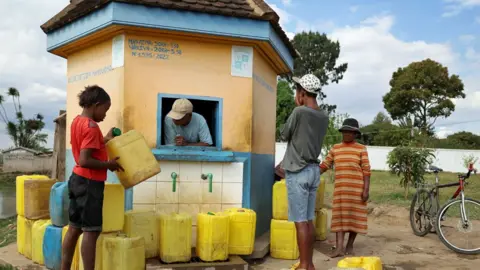 Reuters
ReutersOne of the main protest organisers, who requested anonymity for safety reasons and organized our interview near the rice paddies, told the BBC that he had to walk a mile every day to get water from a well – and he considers himself middle class.
“To be young in Madagascar, you have to be tough,” he adds, explaining that insecurity is widespread.
“You live in constant fear of the time when your home will be broken into, or when people will shoot you, or when you will be stabbed in the streets. It’s as if your humanity has been stolen from you and taken away from you.”
He calls for “radical change” to deal with the island’s chronic social and economic challenges.
According to Heri Ramyarison, a professor of economics at the University of Antananarivo, this is the result of decades of poor economic planning and the government’s failure to create inclusive wealth.
“There is a big employment problem among young people,” he explains.
“It stems from very low levels of education in the workforce, serious deficiencies in the education system in terms of quantity and quality, widespread school dropouts, and the almost complete absence of appropriate training opportunities for them.”
The academic finds it remarkable that 64 years after independence, three-quarters of the population have an education level below primary school, while only 3% have achieved higher education.
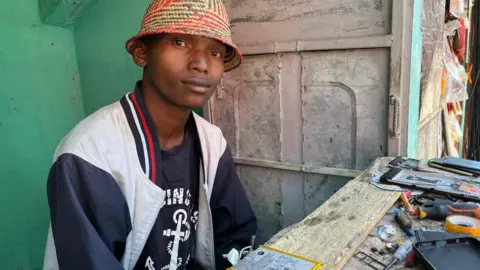 Sami Awami/BBC
Sami Awami/BBCPresident Rajoelina asked the people of Madagascar to give him one year to fix the problems that led to the protests, saying he would resign if he failed to meet the deadline.
But Professor Ramyarison feels that the president does not understand the complexities of how Madagascar is caught in two vicious cycles of poverty that feed each other.
One is driven by weak economic growth, and the other stems from political instability, which discourages investment and growth, pushes people into deeper levels of poverty, and fuels social unrest.
“To break free from the poverty trap, it is first necessary to break the initial vicious cycle by addressing its root causes – the main determinants of economic growth,” he says.
Madagascar has seen frequent political unrest since gaining independence from France, including mass protests in 2009 that ousted then-President Marc Ravalomanana – a once-popular dairy magnate.
This saw the rise of Rajoelina, a former DJ and then mayor of Antananarivo, who seized power in the aftermath.
“Once they come to power, they forget us,” Brenda says from his roadside phone shop. “It’s always the same.”
More on the Gen Z crisis in Madagascar:
 Getty Images/BBC
Getty Images/BBC
https://ichef.bbci.co.uk/news/1024/branded_news/a3f5/live/8ef79850-a5da-11f0-b741-177e3e2c2fc7.jpg
Source link
